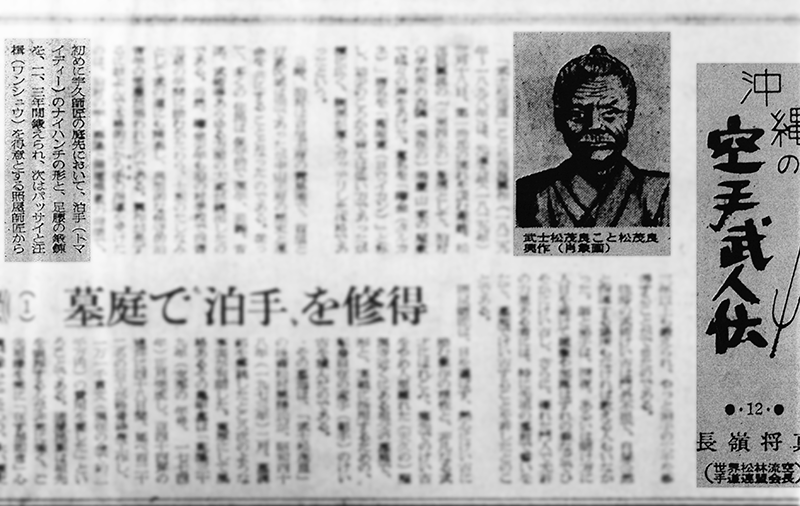There is a interesting detail to Nagamine Shōshin sensei‘s Naihanchi, which has rarely been adressed, if ever. Namely, each step in this kata is performed with the leg raise referred to as nami-gashi (lit. returning wave). This continuous nami-gashi is performed in each of Naihanchi Shodan, Nidan, and Sandan and seems to be a unique feature of Matsubayashi-ryū when compared to the Kobayashi-ryū Naihanchi of Itosu-Chibana lineage.
There are also other schools who have what they call a Tomari Nahanchi, but I don’t know their technical details and personal traditions. Looking at old videos, though, they also perform a continuous nami-gaeshi, such as seen in the Matsumora-ryū of Yara Chōi. Yara was a disciple of Kuba Chōjin, which happened to be a teacher of Nagamine as well, and this Yara also served as an instructor at the Nagamine dōjō in the 1950s.
Nagamine Shōshin sensei wrote about the when and how certain kata of Tomari were handed down (Note 1).
Matsumora Kōsaku, also known as “Bushi Matsumora of Tomari,” was born on March 18, 1829, in the village of Tomari, as the eldest son of Matsumora Kōten of the Yō clan, which descended from the 1st Dynasty of the Royal Shō Clan. His baby birth cry was heard at their mansion at Zuikeizan [maybe an old location that is now lost], which was located to the west of Tomari Village School. His childhood name was Tarukane and his Chinese-style name was Yō Ikan.
Although he was of short height, he had broad shoulders, a large chest, and a sturdy physique. At that time, Tomari Village was an administrative area separated from Shuri, but it was a trading port for the royal government in Shuri, and so it shared the history and fate of the royal government of Ryūkyū. Therefore, people from Tomari were generally conservative, and experts in fields such as Chinese characters, performing arts, music, and martial arts also appeared one after the other.
Naturally, while young boy Tarukane studied the “Four Books and Five Classics of Confucianism” at Tomari Village School, as a member of the samurē class, he also devoted himself to the way of martial arts and cultivated the typical ideology of a young conservative man from Tomari.
He received serious karate instruction from masters Uku Karyū and Teruya Kishin, both from Tomari. First, he worked with Master Uku in his garden for three years, where he trained Naihanchi of Tomari-te and thoroughly strengthened his legs and hips.
Next, under Master Teruya, he studied the master’s specialties of Passai and Wanshū for more than three years and was finally able to master the majority of Tomari-te.
Was this the earliest reference to the masters Uku Karyū and Teruya Kishin and to Naihanchi, Passai and Wanshū as kata handed down in Tomari?
Actually, Nagamine published the same details including about “Naihanchi of Tomari-te” already seven years earlier, in December 1979 (Note 2).
Again nine years earlier, Nagamine Shōshin provided a biography of Matsumora Kōsaku for a “Brief Biography of Warrior Matsumora Kōsaku – Ancestor of Tomari-te Karate,” which was published by Matsumora Kōshō, probably a descendant of “Warrior Matsumora.” (Note 3)
Moreover, in his personal notebook, which includes data and records about interviews with famous martial artists and other research, Nagamine collected some of his research on “venerable Matsumora Kōsaku of the Yō-clan.” This is where he probably first wrote down by hand his research that Matsumora Kōsaku was born on 18 March 1829 in Tomari Village as the oldest son of Matsumora Kōten, that his childhood name was Tarugani, and that his Chinese-style name Yō Ikan. From other data such as the names of his three daughters and two sons, as well as the fact that he mentions that “Matsumora Kōsaku’s mortuary tablet was handed over to Matsumora Kōban and further to Matsumora Kōmei of Onna Village,” and that he provides the address of the then-current head of family in Gushikawa Village Agena 203, who ran a taxi company at the time, there can be little doubt that Nagamine spared no effort to deeply research the genealogy of Matsumora and interview the family members. Therefore, information such as the following are most reliable (Note 4):
Matsumora Kōsaku died on November 7, 1898. He was 70 years old. The founder and 1st generation of the Yō-clan from Tomari was Kochinda Pēchin Kōchō, a grandson of King Shō Toku, the 7. King of the 1st Dynasty of the Royal Shō-clan. Kōsaku’s father Kōten was the 11th generation of this family, and Kōsaku himself was the 12th generation.
Is Naihanchi performed with continuous nami-gaeshi an antique method of Tomari-te? This question cannot be answered for various reasons. For instance, various versions of Naihanchi were probably used in various regions, and mixed over time. More recently, “Tomari” became sort of a buzzword used inflationary and it is difficult to confirm or refute any of these. This is why it is interesting and important to study seeming tiny details in the kata.
Besides his lifelong practice and teaching efforts, it can be said that Nagamine Shōshin’s study, records, interviews, and genealogical study truly constituted the “whisteling arrow of research” into the study of Okinawa Karate.
Biblio
Note 1: Nagamine Shōshin: Biographies of Okinawa Karate and Sumō Masters – Based on Historical Facts and Oral Traditions (Shijitsu to kuden ni yoru Okinawa karate sumō meijin-den). 1986, pp. 57-58.
Note 2: Nagamine Shōshin: Biographies of Okinawan Martial Artists of Karate – Matsumora Kōsaku (1) (Okinawa no Karate Bujin-den – Matsumora Kōsaku (1))
Note 3: Matsumora Kōshō: Brief Biography of Warrior Matsumora Kōsaku – Ancestor of Tomari-te Karate (Bushi Matsumora Kōsaku Ryakuden: Karate (Tomari-te) Chūkō no So). Naha 1970.
Note 4: Handwritten Records by Nagamine Shōshin. Copy made by the author.
© 2023, Andreas Quast. All rights reserved.

